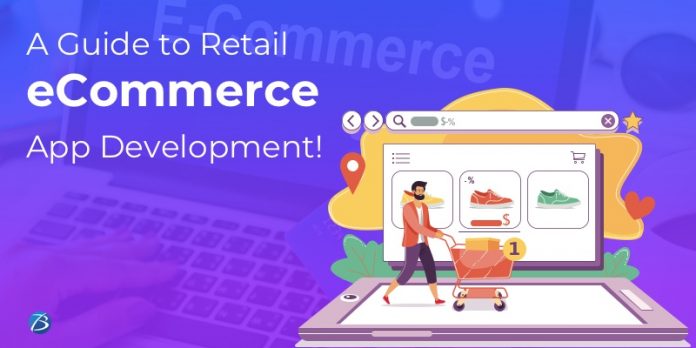eCommerce apps have become an integral part of our lives these days. And, in this era of smartphones, the most recent trend is mCommerce – online purchases via mobile apps.
Take a look at the statistics provided below to understand the importance of eCommerce applications.
The online portal wpforms says that: “93.5% of the internet users across the globe have made online purchases.”
The renowned online research portal “BusinessofApps” stated that: “In the US, mobile eCommerce sales accounted for 7.3% of the total sales in the retail sector, the total eCommerce sales being 53%.”
As per research conducted by “Similarweb” based on the e-commerce data collected from the top hundred websites of the US, in the year 2022 there were 14.6 billion visits including 131.9 unique visitors on ecommerce sites.
As the concept of online marketplaces gains traction, eCommerce mobile app development is in full swing. Even small businesses are considering building eCommerce apps for expanding their customer base.
This post throws light on all the crucial aspects that you need to know for eCommerce app development.
Let’s have a look at the eCommerce App Architecture sketch:
eCommerce App Development: Key Steps
Business Strategy
Conduct extensive research to know the requirements of your target audience. Analyze competitors to get an idea about the most popular eCommerce app features and the commonest mistakes to avoid. Identify some unique setting points that will make your app stand out. Also, consider the project expenses and your budget.
Platform Selection
Pick a scalable app development framework, CMS, and database. Decide whether you will build a native app for Android or iOS or would like to build an app that caters to both of these platforms. It is important to select suitable technology stacks for back-end; front-end; platform, libraries, & interfaces for development; and supportive technologies for performance and security practices.
Feature Set
Select the feature set as per your budget and the requirements of your target audience. The popular features for eCommerce apps include user profiles, authorization, home screen, smart search with filtering/sorting, product lists, product screens with images & description, shopping cart, wish list, instant checkout, barcode scanner, payment gateways, order tracking, push notifications, consumers support, and consumer ratings and reviews.
UI/UX Designing
Create a captivating UI/UX design with attractive visuals, apt color schemes, and smooth transitions.
App Development
Now it’s time to convert your app idea and wireframes into an actual app by doing the development and consider the necessary integrations like payment gateways, app builders, etc.
API Integration
API integrations are necessary for promoting data exchange between different frameworks and implementing certain necessary app features. For example, eCommerce apps need APIs for integrating payment gateways, shipping prerequisites, marketing automation, and consumer data analysis.
Maintenance
Maintenance and support services post-deployment is necessary to resolve bugs and roll out periodic updates to stay relevant and accommodate customer needs.
Important Tip for successful app development: It’s a good idea to partner with an experienced app development company in USA that offers end-to-end services right from app ideation to deployment and maintenance post-deployment.
eCommerce App Development: Crucial Aspects to Consider
User-friendliness
Ease of usage and user-friendliness are important aspects to consider while eCommerce app development. Create a user interface that is intuitive and easily understandable. Users must be able to effortlessly navigate to product categories and your home screen should display popular products and lucrative deals. A considerable amount of text and animations should be avoided as this can add to the app’s complexity.
Simple registration and checkout process are key factors that minimize the chances of cart abandonment. This is because, time-consuming and complex login or checkout processes will repel customers away from your app. Also, offer facilities like logging in via social media, shopping as a guest, etc. Enable users to save some of their details for future purchases so that they do not have to re-enter the same information next time. Also, your “add to cart” button should be prominent enough to be easily noticed by online shoppers.
Clarity of images
Several consumers may be reluctant to make expensive online purchases without testing the product properly. To mitigate this challenge, retailers these days provide visual clarity of product images. It’s a good practice to post several pictures of the same product clicked from various angles so that consumers get a clear idea about the product before making a purchase decision. The image resolution must be high and users should be able to zoom the images for better clarity. Some retail brands offer videos displaying their product.
Speed, Responsiveness, and Stability
New-age consumers are impatient and easily frustrated if an app is slow. Hence, your app must load speedily and allow users quick navigation while browsing through product categories. Moreover, the app must be responsive across all kinds of device screens. For this reason, it is necessary to conduct usability testing on all kinds of device screens while eCommerce app development.
You need to make sure that your app is stable, consistent, well balanced, and has minimal incidents of app crashes and other related issues. Or else, your eCommerce app will poorly perform and may be abandoned by users. To ensure stability with regard to app performance, it’s important to develop your app in iterations and conduct extensive QA testing. Do not forget to collect user feedback, resolve issues at the earliest, and roll out periodic updates to stay relevant.
Concluding Thoughts:
Today, retail businesses that intend to expand customer outreach, serve customers 24X7, provide an unparalleled experience to consumers, and boost sales, must possess an eCommerce mobile application to support their website. The aforesaid tips and best practices will help you to develop a best-selling eCommerce application for your business.







